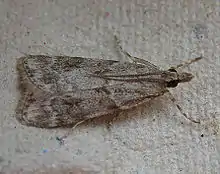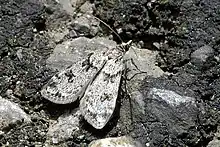Scoparia ambigualis
Scoparia ambigualis is a species of moth of the family Crambidae described by Friedrich Treitschke in 1829. It is found in Europe and Asia Minor and possibly in Guangdong and Shanxi in China.[1]
| Scoparia ambigualis | |
|---|---|
 | |
 | |
| Scientific classification | |
| Domain: | Eukaryota |
| Kingdom: | Animalia |
| Phylum: | Arthropoda |
| Class: | Insecta |
| Order: | Lepidoptera |
| Family: | Crambidae |
| Genus: | Scoparia |
| Species: | S. ambigualis |
| Binomial name | |
| Scoparia ambigualis (Treitschke, 1829) | |
| Synonyms | |
| |
The wingspan is 15–22 mm. The forewings are whitish, more or less sprinkled with grey and black; a black ochreous-mixed mark from base of costa; lines whitish, dark -edged, first irregular, second angulated above middle; orbicular elongate, brownish, more or less black-edged, resting on first line; claviform dot- like, black, seldom elongated to touch first line; discal spot 8-shaped, incompletely black edged, upper and sometimes lower half pale greyish-ochreous or brownish; terminal area dark, subterminal line cloudy, whitish; a terminal series of blackish marks. Hindwings are prismatic grey-whitish, terminally suffused with grey.[2]
The moth flies from May to September depending on the location.
The larvae feed on valerian and probably also on various mosses.
References
- Li, Weichun; Li, Houhun; Nuss, Matthias (September 13, 2010). "Taxonomic revision of Scoparia Haworth, 1811 (Lepidoptera: Crambidae: Scopariinae) from China" (PDF). Zootaxa. 2609: 1–33.
- Meyrick, E., 1895 A Handbook of British Lepidoptera MacMillan, London pdf
 This article incorporates text from this source, which is in the public domain. Keys and description
This article incorporates text from this source, which is in the public domain. Keys and description
External links
- Waarneming.nl (in Dutch) Archived 2012-07-29 at the Wayback Machine
- Lepidoptera of Belgium
- Scoparia ambigualis at UKMoths